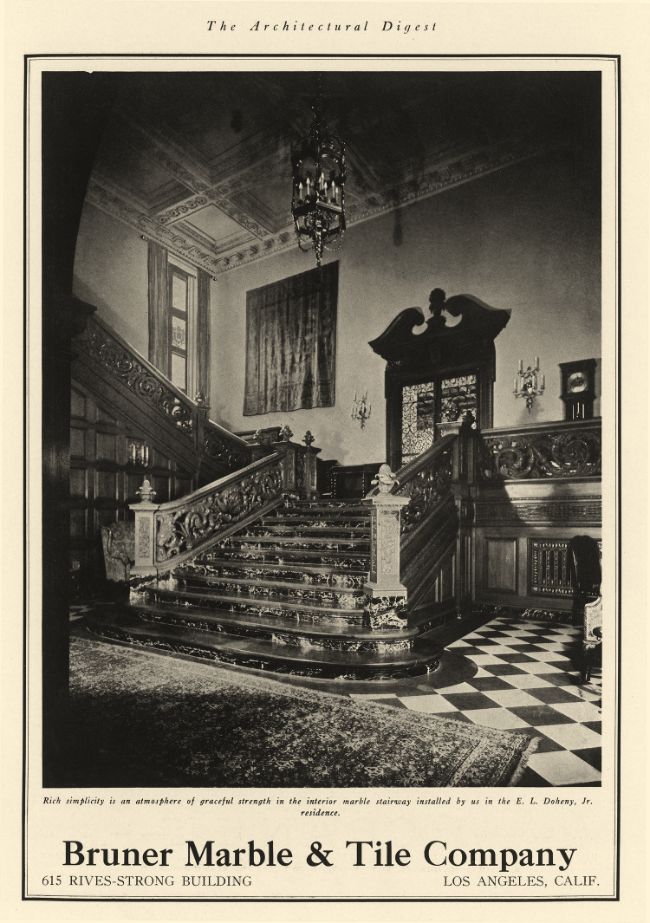The Greystone mansion in Beverly Hills, has a notorious past: built by the immense wealth of oil barons, touched by a scandal involving corruption and the scene of a murder never fully explained. It was eventually left to deteriorate until it gained a new life as a national landmark and property of the City of Beverly Hills. The imposing castle on a hill has a story to rival any movie plot, which may be appropriate for an estate in the heart of Beverly Hills.
The story of Greystone begins in 1892, when a broke Doheny Sr. realized the potential of the oil tar that was being used locally in place of coal. He borrowed the $400 he needed to lease a promising piece of land…then literally began digging for oil with a pick and shovel, because he couldn’t afford a drilling rig. Surprisingly, he managed to strike oil in what would be the first oil well in Los Angeles.
He later purchased a property in Mexico which became the greatest oil discovery in history, producing a quarter million barrels of oil per day at its peak. And Doheny Sr. became an extremely wealthy man.
What does one do with such wealth? Doheny Sr. decided to build the grandest mansion in Southern California for his son Ned and his family. He already owned the 429-acre Doheny Ranch, a working cattle ranch with avocado and citrus groves. He set aside 22 acres of it for the new estate, then hired architect Gordon B. Kaufmann and landscape designer Paul G. Thiene to construct a $4 million English Tudor-style castle which radiated stateliness and grandeur. From the gray stone façade to marble staircases, vaulted ceilings and a terrace with a view of the Los Angeles Basin, Greystone was the epitome of old money.
Unfortunately, the Doheny’s became involved in a national scandal when they loaned money to a friend to cover his back taxes. But it wasn’t just any friend: they loaned money to Albert Fall, the secretary of the interior who was in charge of government oil reserves. And they didn’t just loan him money: they hand-delivered $100,000 cash to him, bundled with rubber bands. When Fall got a law changed which opened up government oil reserves to private development, the resulting Teapot Dome Scandal embroiled Fall and the Doheny’s in civil and criminal trials for years.
Greystone became a retreat from the harsh glare of the public spotlight. But tragedy followed the Doheny’s home. Ned Doheny and his family had barely begun enjoying the mansion when Hugh Plunkett showed up at the estate. Plunkett, Ned’s secretary and friend, had been involved in delivering the money to Fall. Ned called a family doctor to treat the agitated Plunkett; the doctor arrived in time to hear two gunshots. Plunkett was dead and Ned was dying. It was clearly a murder-suicide. But who was the murderer? And why? The Los Angeles District Attorney squelched the investigation, but rumors abounded. Were Ned and Hugh lovers? Or was Plunkett distressed at the possibility of going to jail for his involvement in Teapot Dome?
After Ned’s death, his widow remarried and moved from Greystone. The estate gradually deteriorated until 1965, when the City of Beverly Hills purchased the grounds to build a new reservoir. The American Film Institute leased and repaired the building in 1969. But ultimately, the City declared Greystone a public park and it became a national landmark.
It is no longer occupied, but it still draws filmmakers, photographers, weddings…and witnesses who have seen the ghost of a weeping woman wandering the halls, one last mystery for a national landmark with a storied, if tragic, past.
Written by the David Kramer Group | Based on an article in the Book, The Legendary Estates of Beverly Hills, By Jeff Hyland


